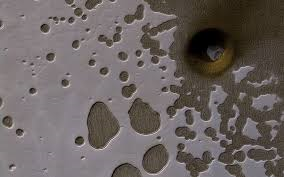Nasa has shared a picture of an “unusual” hole in the Martian surface that could serve as a home for life.
The hole appears to be the entrance to a larger underground cavern, which can be seen a little in the image and could serve as protection
The image was discovered in 2011, by chance – it was spotted as art of a broader series of images, taken of the slopes of Mars’ Pavonis Mons volcano, using the Mars Reconnaissance Orbiter that continues to orbit around the planet to this day.
When the hole was discovered, Nasa conducted further analysis that suggested the cavern goes around 20 meters deep. It could not find an explanation for the circular crater that surrounds the hole – or a proper estimate of just how far the underlying cavern might extend.
“Holes such as this are of particular interest because their interior caves are relatively protected from the harsh surface of Mars, making them relatively good candidates to contain Martian life,” Nasa wrote on its Astronomy Picture of the Day page, where it shared the image this week.
“These pits are therefore prime targets for possible future spacecraft, robots, and even human interplanetary explorers.”
In the time since the image was taken, Nasa has continued to scour the surface of Mars for more possible cave openings on the surface.
The hunt is by extension a mission to look for potential underground habitats, since researchers speculate that while there is no evidence of alien life on the surface, it could be hidden underneath the red planet.
Caverns could also be useful places for future human explorers to shelter from the harsh environment on the Martian surface.
Those explorers could also examine the materials found in those caverns. Since they could include material left their from previous epochs, they may prove a useful way of looking back into Mars’ past.
Nasa is only recently starting to dig unto the large unexplored world beneath the Martian surface. Last week, it showed off the first findings from the InSight spacecraft, which revealed that Mars was seismically active and more, in findings that could help reveal how the red planet was formed.
The Independent
 Lebanese Ministry of Information
Lebanese Ministry of Information



